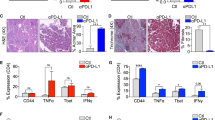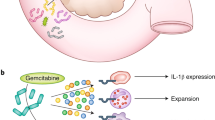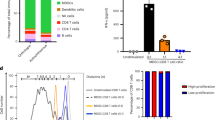Abstract
Despite recent advancements in multimodal therapy, pancreatic ductal adenocarcinoma (PDA) continues to have a dismal prognosis. In the era of burgeoning immune therapies against previously difficult-to-treat malignancies, there has been growing interest in activating the immune system against PDA; however, unlike in other cancers such as melanoma and lymphoma, immunotherapy has not yielded many clinically significant results. To harness these mechanisms for therapeutic use, an in-depth understanding of T-cell programming in the immune microenvironment of PDA must be achieved. The outcome of T-cell programming against pathogens or cancer depends on the uptake and presentation of foreign antigens by dendritic cells and macrophages to T cells, and the expression of various co-stimulatory molecules and cytokines. Subsequent immune responses are kept in check via regulatory mechanisms such as immune checkpoints (for example, programmed cell death protein 1 (PD-1) and cytotoxic T lymphocyte-associated protein 4 (CTLA-4)), as well as other immunosuppressive cell types such as regulatory T cells (Treg) and M2 macrophages. PDA presents a challenge from the perspective of immune therapy because of many immunosuppressive mechanisms at play in its microenvironment. The tumor itself produces IL-10 and transforming growth factor beta (TGF-β) that downregulate T-cell activation as well as the activity of antigen-presenting cells. At the same time, PDA also appears to recruit more regulatory elements into its milieu; higher infiltration of Treg, for instance, has been associated with poorer prognosis in PDA patients. M2 macrophages and myeloid-derived suppressive cells are also highly prevalent in the tumor microenvironment. T cells in PDA have high expression of PD-1, whereas the tumor has high expression of PD-L1, which likely inhibits activation of tumor antigen-specific T cells. Many of these immunosuppressive mechanisms have been targeted as potential immune therapies of PDA. Immune checkpoint inhibitors, which target PD-1 and CTLA-4, have been shown to be effective in other cancers such as melanoma; however, they have not demonstrated outcome benefits in PDA so far. Other novel investigational approaches under study currently include inhibiting the homing of immunosuppressive cell types to the tumor milieu, as well as vaccines designed to boost the adaptive response to PDA antigens. As our understanding of the nuanced and complex interactions of the immune microenvironment expands, more targeted approaches can be taken toward achieving therapeutic success in immune therapy against PDA.
This is a preview of subscription content, access via your institution
Access options
Subscribe to this journal
Receive 12 print issues and online access
$259.00 per year
only $21.58 per issue
Buy this article
- Purchase on Springer Link
- Instant access to full article PDF
Prices may be subject to local taxes which are calculated during checkout


Similar content being viewed by others
References
Siegel R, Ma J, Zou Z, Jemal A . Cancer statistics, 2014. CA Cancer J Clin 2014; 64: 9–29.
Simard EP, Ward EM, Siegel R, Jemal A . Cancers with increasing incidence trends in the United States: 1999 through 2008. CA Cancer J Clin 2012; 62: 118–128.
Emmrich J, Weber I, Nausch M, Sparmann G, Koch K, Seyfarth M et al. Immunohistochemical characterization of the pancreatic cellular infiltrate in normal pancreas, chronic pancreatitis and pancreatic carcinoma. Digestion 1998; 59: 192–198.
Fukunaga A, Miyamoto M, Cho Y, Murakami S, Kawarada Y, Oshikiri T et al. CD8+ tumor-infiltrating lymphocytes together with CD4+ tumor-infiltrating lymphocytes and dendritic cells improve the prognosis of patients with pancreatic adenocarcinoma. Pancreas 2004; 28: e26–e31.
Shibuya KC, Goel VK, Xiong W, Sham JG, Pollack SM, Leahy AM et al. Pancreatic ductal adenocarcinoma contains an effector and regulatory immune cell infiltrate that is altered by multimodal neoadjuvant treatment. PLoS One 2014; 9: e96565–13.
Abbas AK, Lichtman AHH, Pillai S . Cellular and Molecular Immunology, 8 edn. Saunders: Philadelphia, PA, USA, 2014.
Wang T, Niu G, Kortylewski M, Burdelya L, Shain K, Zhang S et al. Regulation of the innate and adaptive immune responses by Stat-3 signaling in tumor cells. Nat Med 2003; 10: 48–54.
Dallal RM, Christakos P, Lee K, Egawa S, Son Y-I, Lotze MT . Paucity of dendritic cells in pancreatic cancer. Surgery 2002; 131: 135–138.
Tjomsland V, Sandström P, Spångeus A, Messmer D, Emilsson J, Falkmer U et al. Pancreatic adenocarcinoma exerts systemic effects on the peripheral blood myeloid and plasmacytoid dendritic cells: an indicator of disease severity? BMC Cancer 2010; 10: 581–14.
Hirooka S, Yanagimoto H, Satoi S, Yamamoto T, Toyokawa H, Yamaki S et al. The role of circulating dendritic cells in patients with unresectable pancreatic cancer. Anticancer Res 2011; 31: 3827–3834.
Yanagimoto H, Takai S, Satoi S, Toyokawa H, Takahashi K, Terakawa N et al. Impaired function of circulating dendritic cells in patients with pancreatic cancer. Clin Immunol 2005; 114: 52–60.
Bellone G, Novarino A, Vizio B, Brondino G, Addeo A, Prati A et al. Impact of surgery and chemotherapy on cellular immunity in pancreatic carcinoma patients in view of an integration of standard cancer treatment with immunotherapy. Int J Oncol 2009; 34: 1701–1715.
Hiraoka N, Onozato K, Kosuge T, Hirohashi S . Prevalence of FOXP3+ regulatory t cells increases during the progression of pancreatic ductal adenocarcinoma and its premalignant lesions. Clin Cancer Res 2006; 12: 5423–5434.
Ene Obong A, Clear AJ, Watt J, Wang J, Fatah R, Riches JC et al. Activated pancreatic stellate cells sequester CD8+ T cells to reduce their infiltration of the juxtatumoral compartment of pancreatic ductal adenocarcinoma. Gastroenterology 2013; 145: 1121–1132.
Trapani JA . The dual adverse effects of TGF-β secretion on tumor progression. Cancer Cell 2005; 8: 349–350.
Thomas DA, Massagué J . TGF-β directly targets cytotoxic T cell functions during tumor evasion of immune surveillance. Cancer Cell 2005; 8: 369–380.
Ryschich E, Nötzel T, Hinz U, Autschbach F, Ferguson J, Simon I et al. Control of T-cell-mediated immune response by HLA class I in human pancreatic carcinoma. Clin Cancer Res 2005; 11: 498–504.
Dong H, Strome SE, Salomao DR, Tamura H, Hirano F, Flies DB et al. Tumor-associated B7-H1 promotes T-cell apoptosis: a potential mechanism of immune evasion. Nat Med 2002; 8: 793–800.
Peggs KS, Quezada SA, Chambers CA, Korman AJ, Allison JP . Blockade of CTLA-4 on both effector and regulatory T cell compartments contributes to the antitumor activity of anti-CTLA-4 antibodies. J Exp Med 2009; 206: 1717–1725.
Tassi E, Gavazzi F, Albarello L, Senyukov V, Longhi R, Dellabona P et al. Carcinoembryonic antigen-specific but not antiviral CD4+ T cell immunity is impaired in pancreatic carcinoma patients. J Immunol 2008; 181: 6595–6603.
Gabitass RF, Annels NE, Stocken DD, Pandha HA, Middleton GW . Elevated myeloid-derived suppressor cells in pancreatic, esophageal and gastric cancer are an independent prognostic factor and are associated with significant elevation of the Th2 cytokine interleukin-13. Cancer Immunol Immunother 2011; 60: 1419–1430.
Bellone G, Turletti A, Artusio E, Mareschi K, Carbone A, Tibaudi D et al. Tumor-associated transforming growth factor-β and interleukin-10 contribute to a systemic Th2 immune phenotype in pancreatic carcinoma patients. Am J Pathol 1999; 155: 537–547.
De Monte L, Reni M, Tassi E, Clavenna D, Papa I, Recalde H et al. Intratumor T helper type 2 cell infiltrate correlates with cancer-associated fibroblast thymic stromal lymphopoietin production and reduced survival in pancreatic cancer. J Exp Med 2011; 208: 469–478.
Tan MCB, Goedegebuure PS, Belt BA, Flaherty B, Sankpal N, Gillanders WE et al. Disruption of CCR5-dependent homing of regulatory T cells inhibits tumor growth in a murine model of pancreatic cancer. J Immunol 2009; 182: 1746–1755.
Nummer D, Suri-Payer E, Schmitz-Winnenthal H, Bonertz A, Galindo L, Antolovich D et al. Role of tumor endothelium in CD4+CD25+ regulatory T cell infiltration of human pancreatic carcinoma. J Natl Cancer Inst 2007; 99: 1188–1199.
Bingle L, Brown NJ, Lewis CE . The role of tumour-associated macrophages in tumour progression: implications for new anticancer therapies. J Pathol 2002; 196: 254–265.
Kurahara H, Shinchi H, Mataki Y, Maemura K, Noma H, Kubo F et al. Significance of M2-polarized tumor-associated macrophage in pancreatic cancer. J Surg Res 2011; 167: e211–e219.
Yoshikawa K, Mitsunaga S, Kinoshita T, Konishi M, Takahashi S, Gotohda N et al. Impact of tumor-associated macrophages on invasive ductal carcinoma of the pancreas head. Cancer Sci 2012; 103: 2012–2020.
Kimsey TF, Campbell AS, Albo D, Wilson M, Wang TN . Co-localization of macrophage inflammatory protein-3alpha (Mip-3alpha) and its receptor, CCR6, promotes pancreatic cancer cell invasion. Cancer J 2004; 10: 374–380.
Campbell AS, Albo D, Kimsey TF, White SL, Wang TN . Macrophage inflammatory protein-3alpha promotes pancreatic cancer cell invasion. J Surg Res 2005; 123: 96–101.
Clark CE, Hingorani SR, Mick R, Combs C, Tuveson DA, Vonderheide RH . Dynamics of the immune reaction to pancreatic cancer from inception to invasion. Cancer Res 2007; 67: 9518–9527.
Diaz-Montero CM, Salem ML, Nishimura MI, Garrett-Mayer E, Cole DJ, Montero AJ . Increased circulating myeloid-derived suppressor cells correlate with clinical cancer stage, metastatic tumor burden, and doxorubicin–cyclophosphamide chemotherapy. Cancer Immunol Immunother 2008; 58: 49–59.
Schnurr M, Scholz C, Rothenfusser S, Galambos P, Dauer M, Robe J et al. Apoptotic pancreatic tumor cells are superior to cell lysates in promoting cross-priming of cytotoxic T cells and activate NK and gammadelta T cells. Cancer Res 2002; 62: 2347–2352.
Akiyama Y, Maruyama K, Nara N, Hojo T, Cheng JY, Mori T et al. Antitumor effects induced by dendritic cell-based immunotherapy against established pancreatic cancer in hamsters. Cancer Lett 2002; 184: 37–47.
Morse MA, Nair SK, Boczkowski D, Tyler D, Hurwitz HI, Proia A et al. The feasibility and safety of immunotherapy with dendritic cells loaded with CEA mRNA following neoadjuvant chemoradiotherapy and resection of pancreatic cancer. Int J Gastrointest Cancer 2002; 32: 1–6.
Zhu Y, Knolhoff BL, Meyer MA, Nywening TM, West BL, Luo J et al. CSF1/CSF1R blockade reprograms tumor-infiltrating macrophages and improves response to T-cell checkpoint immunotherapy in pancreatic cancer models. Cancer Res 2014; 74: 5057–5069.
Tassi E, Braga M, Longhi R, Gavazzi F, Parmiani G, Di Carlo V et al. Non-redundant role for IL-12 and IL-27 in modulating Th2 polarization of carcinoembryonic antigen specific CD4 T cells from pancreatic cancer patients. PLoS One 2009; 4: e7234–e7238.
Bunt SK, Mohr AM, Bailey JM, Grandgenett PM, Hollingsworth MA . Rosiglitazone and gemcitabine in combination reduces immune suppression and modulates T cell populations in pancreatic cancer. Cancer Immunol Immunother 2012; 62: 225–236.
Ellermeier J, Wei J, Duewell P, Hoves S, Stieg MR, Adunka T et al. Therapeutic efficacy of bifunctional siRNA combining TGF- 1 silencing with RIG-I activation in pancreatic cancer. Cancer Res 2013; 73: 1709–1720.
Soares KC, Rucki AA, Wu AA, Olino K, Xiao Q, Chai Y et al. PD-1/PD-L1 blockade together with vaccine therapy facilitates effector T-cell infiltration into pancreatic tumors. J Immunother 2015; 38: 1–11.
Postow MA, Chesney J, Pavlick AC, Robert C, Grossmann K, McDermott D et al. Nivolumab and ipilimumab versus ipilimumab in untreated melanoma. N Engl J Med 2015; 372: 2006–2017.
Eggermont A, Chiarion-Sileni V, Jean-Jacques Grob P, Reinhard Dummer P, Wolchok JD, Schmidt H et al. Adjuvant ipilimumab versus placebo after complete resection of high-risk stage III melanoma (EORTC 18071): a randomised, double-blind, phase 3 trial. Lancet Oncol 2015; 16: 522–530.
Royal RE, Levy C, Turner K, Mathur A, Hughes M, Kammula US et al. Phase 2 trial of single agent Ipilimumab (anti-CTLA-4) for locally advanced or metastatic pancreatic adenocarcinoma. J Immunother 2010; 33: 828–833.
Aida K, Miyakawa R, Suzuki K, Narumi K, Udagawa T, Yamamoto Y et al. Suppression of Tregs by anti-glucocorticoid induced TNF receptor antibody enhances the antitumor immunity of interferon-α gene therapy for pancreatic cancer. Cancer Sci 2014; 105: 159–167.
Sanford DE, Porembka MR, Panni RZ, Mitchem JB, Belt BA, Plambeck-Suess SM et al. A study of zoledronic acid as neo-adjuvant, perioperative therapy in patients with resectable pancreatic ductal adenocarcinoma. J Cancer Ther 2013; 4: 797–803.
Nywening TM, Wang-Gillam A, Sanford DE, Belt BA, Panni RZ, Cusworth BM et al. Targeting tumour-associated macrophages with CCR2 inhibition in combination with FOLFIRINOX in patients with borderline resectable and locally advanced pancreatic cancer: a single-centre, open-label, dose-finding, non-randomised, phase 1b trial. Lancet Oncol 2016; 17: 651–662.
Le DT, Wang-Gillam A, Picozzi V, Greten TF, Crocenzi T, Springett G et al. Safety and survival with GVAX pancreas prime and Listeria monocytogenes-expressing mesothelin (CRS-207) boost vaccines for metastatic pancreatic cancer. J Clin Oncol 2015; 33: 1325–1333.
Pillarisetty VG . The pancreatic cancer microenvironment: an immunologic battleground. OncoImmunology 2014; 3: e950171–e950173.
Author information
Authors and Affiliations
Corresponding author
Ethics declarations
Competing interests
The authors declare no conflict of interest.
Rights and permissions
About this article
Cite this article
Seo, Y., Pillarisetty, V. T-cell programming in pancreatic adenocarcinoma: a review. Cancer Gene Ther 24, 106–113 (2017). https://doi.org/10.1038/cgt.2016.66
Received:
Accepted:
Published:
Issue Date:
DOI: https://doi.org/10.1038/cgt.2016.66
This article is cited by
-
Conditioned media of pancreatic cancer cells and pancreatic stellate cells induce myeloid-derived suppressor cells differentiation and lymphocytes suppression
Scientific Reports (2022)
-
TGF-β Alters the Proportion of Infiltrating Immune Cells in a Pancreatic Ductal Adenocarcinoma
Journal of Gastrointestinal Surgery (2022)
-
The tumor microenvironment in pancreatic ductal adenocarcinoma: current perspectives and future directions
Cancer and Metastasis Reviews (2021)
-
Characterization of spatial distribution of tumor-infiltrating CD8+ T cells refines their prognostic utility for pancreatic cancer survival
Modern Pathology (2019)
-
TGF-β Inhibitors in Metastatic Pancreatic Ductal Adenocarcinoma
Journal of Gastrointestinal Cancer (2019)



